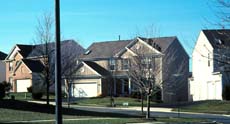index
Typical criticisms of suburbs
click on images for full-size:





Garage front homes, so-called 'snouts'

Security

Tysons Corner offices

Maryland development
[Repetitive uniformity:] When he reaches his destination, he finds . . . only another suburb, just as dull as his own. Boyer 1996, 219, quoting Lewis Mumford
[Sociological Sins:] Created as safe havens from the sociological ills of cities, suburbs now stand accused of creating their own environmental diseases: lack of character and the grounding principles of identity, lack of diversity or the tolerance it engenders, lack of attachment to shared, civic ideals. Increasingly, the newest, largest suburbs are being criticized as landscapes scorched by unthoughtful, repetitious building, where, it has been suggested, the isolations of larger lots and a car-based culture may lead to disassociation from the reality of contact with other people. Hamilton 1999, D1
[Bad design:] The overturned garbage can that is a large part of the American built environment. Benedikt 1999, 10
[Neither Urban nor Rural Form:] Illegitimate hybrids of country and city. . . . these bastard forms degrade both urban and rural space. So far from transcending the conflicts between the two, they thrust both into a confusion. Lefebvre 1991, 387
But on the other hand:
Sprawl has become the whipping boy for a variety of ills, including the destruction of nature, the decline of inner cities, the predominance of consumerism and the loss of civic consciousness. . . . Yet simply demonizing the suburbs -- and idealizing the traditional city -- will not do. For one thing, sprawl was hardly mindless; the industrial American city, with its tenements and downtown factories, was a nasty place. In a country as large as the U. S., a horizontal form of urbanism was probably inevitable." Rybczynski 1999
There are many criticisms of suburban land use practices, environmental impacts, social and political patterns, and so on. In this text I am primarily concerned with the criticism that suburban development does not create real places. I argue that the place structures in suburbia are more complex than they seem and can be be made so by appropriate changes and interventions.